

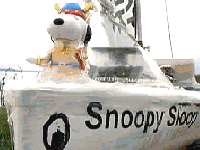

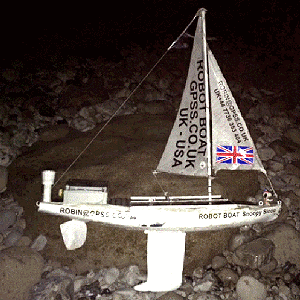 You probably reached here from Snoopy's
GPS Guided Trans-Atlantic Robot Boat page.
If not, click on the link to know more.
You probably reached here from Snoopy's
GPS Guided Trans-Atlantic Robot Boat page.
If not, click on the link to know more.
I set up this page because I expect a lot of discussion soon, by direct email, and on "forums" like the the Microtransat mailing list. This is after Snoopy's crash-landing near Weymouth, sailing in a straight line eastward, with a 30mph wind from the north, when he would probably have been turning hard right, to turn towards his next waypoint, to the West-South-West.
The most likely explanation seems to be "weather helm". This page will need to have the right pictures added, to make it clearer. I'll start with those that I think might be helpful. e.g. that of Snoopy's boat just after the rescue: you can see the relationship of sails to keel. That rudder is pointing slightly towards Dick, who took the picture. Some of you may find suitable material.
I've started this page by just typing it in, off the top of my head, without googling to check my facts or terminology. But if I make this public from Snoopy's front page immediately, I'm sure my friends will point out my mistakes. e.g. anyone can google "weather helm" and find something like a Wiki article: it's reading the article that takes the time :-)
I hate people, including myself, wasting time telling other people what they already know. i.e. "telling grandma to suck eggs". My experience, on subjects related to Snoopy's little robot boat, is that good advice can come from unexpected places.
Luckily for me, I have a small network of friends, including Team-Joker "team-mates", such as John, Peter and Dick, who meet, or exchange emails, to discuss topics such as this - sometimes hour by hour. I try to keep the results of these discussions updated in these "Snoopy" pages, most importantly the "current" Blog page. This means, when emails are frequent, I can reduce the number that I do a "reply all" to. Some of my friends may appreciate reduced "Snoopy email traffic" :-)
Robin Lovelock
December 2014.
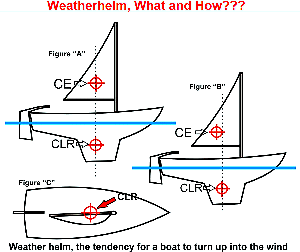 Any person who has sailed a full sized sailing boat will tell you what "weather helm" and "lee helm" are.
So will the radio controlled model boat enthusiast, who may spend time adjusting the trim on his boat
for competition. You can google up, but put simply, "weather helm" is when the force of the wind,
sideways to the boat, tends to make the "pointy end" turn TOWARDS the wind. "Lee Helm" has the opposite
effect - the boat tends to turn downwind.
Any person who has sailed a full sized sailing boat will tell you what "weather helm" and "lee helm" are.
So will the radio controlled model boat enthusiast, who may spend time adjusting the trim on his boat
for competition. You can google up, but put simply, "weather helm" is when the force of the wind,
sideways to the boat, tends to make the "pointy end" turn TOWARDS the wind. "Lee Helm" has the opposite
effect - the boat tends to turn downwind.
Note that I'm avoiding sailing jargon deliberately. e.g. I'll say "right/left" instead of "starboard/port", and "string" instead of "sheets" ("rope" if talking about full sized boats, which I'm not). This is because non-sailors may come up with the best solution here. Some "lateral thinking" may be needed.
"Weather helm" happens if the centre of effort (CE) of the wind on the sails, is behind the Centre of Lateral Resistance (CLR) of the water on the keel. But it's a bit more subtle than that: the CE of the wind on the boat above water - including sails, hull and superstructure - like our big box of electronics at the back; the CLR of the water acting on keel, but also the hull below water, the rudder, and any "skeg" - a fin to protect the rudder.
Googling will find lots of explanations, but this on here had a simple illustration on the right.
Looking at that picture of Snoopy's boat, some might be surprised this would result in weather helm. I'll be interested to hear opinions, after reading all this page - particularly after any mistakes on it have been corrected :-)
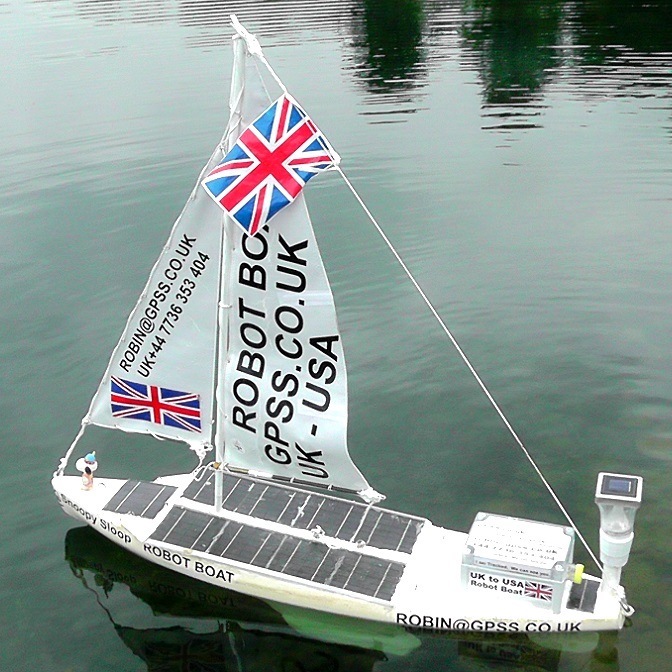 Click on the picture of Boat 10 on the right, to see a bigger version.
This was taken earlier in 2014, before the long broken keel was replaced by a new one
- which could be why we may then have weather helm !
Click on the picture of Boat 10 on the right, to see a bigger version.
This was taken earlier in 2014, before the long broken keel was replaced by a new one
- which could be why we may then have weather helm !
We might do things with our robot boat that are not practical with a full sized boat, or not allowed within model boat competition rules. "Lateral thinkers" may think of other ways. Here are some:
I'm looking for something simple and practical for our existing boat 10. Ideally, after the right sort of tests, only a few hours of work are needed, and then more tests to give confidence that the boat is better balanced. It is the testing that will take the time - particularly if waiting for a day of very strong wind ! I have a friend who has suggested throwing away the rudder, and steering the boat by pumping water balast around it. I've not taken this degree of "lateral thinking" too seriously, even though the same chap has come up with some of the best ideas or products that I've used, in recent years. * Boat 10 is already 15kg and low in the water - I don't water rising further up that rudder post into the box :-)
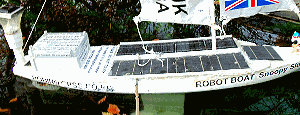
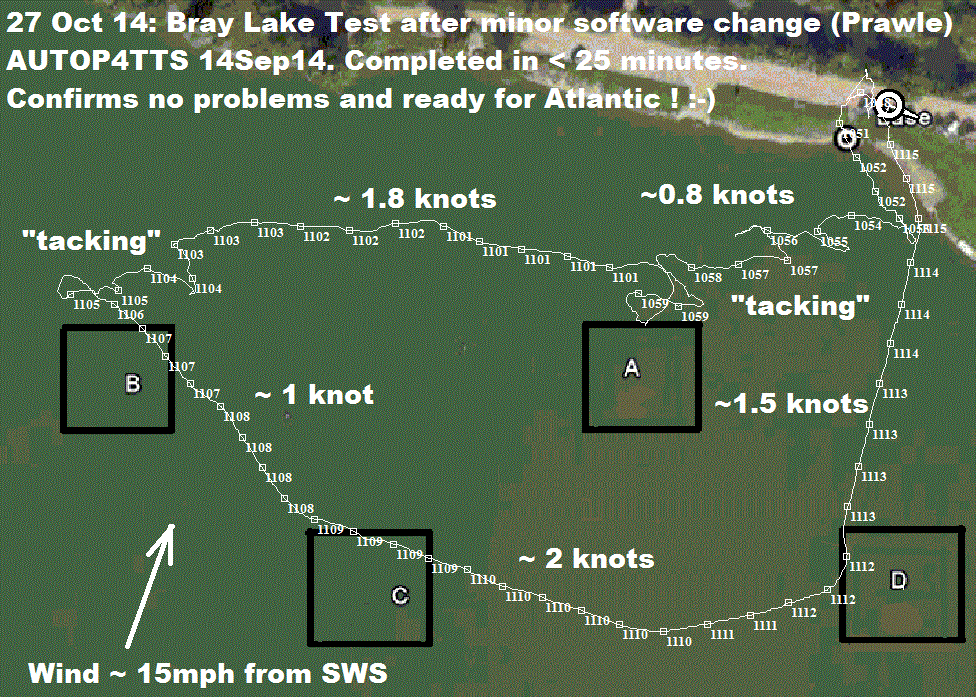 Any model yacht man, after finishing his boat, will probably do a very
simple "balance test". He might use a stick, to push the boat sideways.
There will be a place along the deck which seems to be the Centre of Lateral Resistance (CLR)
of the hull. i.e. when he pushes the boat sideways, the boat does not swing towards,
or away from him. Here we are, doing this test on June's swimming pool, after
Snoopy's survival from his last 2014 attempt. The stick is in the approximate CLR position.
Any model yacht man, after finishing his boat, will probably do a very
simple "balance test". He might use a stick, to push the boat sideways.
There will be a place along the deck which seems to be the Centre of Lateral Resistance (CLR)
of the hull. i.e. when he pushes the boat sideways, the boat does not swing towards,
or away from him. Here we are, doing this test on June's swimming pool, after
Snoopy's survival from his last 2014 attempt. The stick is in the approximate CLR position.
For the sails, he will probably just use some "rule of thumb", like the CoE being a certain distance back along the mainsail boom, from the mast. Here, you see the CoE is well in front of the CLR, so Snoopy could be expected to suffer from Lee Helm rather than Weather Helm. BUT - see the size of that navigation light and electronics box at the back - that would move the CoE back - possibly behind the CLR - causing Weather Helm.
Since 2008, during the regular trips to Bray Lake, the robot boats were equipped with GPS logging, in addition to the autopilot function. So our main source of useful data is the actual "course over ground" (COG) track of the boat. There are numerous "GPS Plots" in our Blogs, the most recent appearing on our front page - that indication that this boat DOES show weather helm, even when the wind is only 15 mph. That fateful night, the wind was closer to 30mph. Click on the picture on the right to read the details.
In recent years we have other "test equipment" on the boats, including the Mobius video camera, but the GPS Plot is the more useful, for looking at this problem.
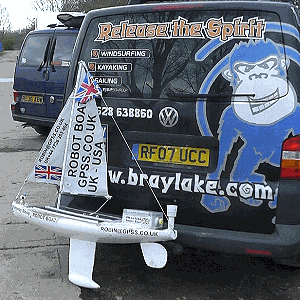 Yes, of course it's more complicated than the above: e.g. the wind force
on the sails makes the boat heel over, so there is less force on those sails,
compared with the rest of the boat - so the CoG on the sails may move to the rear
- "stern" I suppose sailors would say :-)
Note added in January 2015: an expert pointed out to me that, when the boat heels over,
there is a downward pressure, pushing the front of the boat into the water, if the mast is further
forward. This will cause weather helm in stronger winds. This is an argument for
having the mast further back, in it's conventional position, and using different means of reducing
weather helm.
Yes, of course it's more complicated than the above: e.g. the wind force
on the sails makes the boat heel over, so there is less force on those sails,
compared with the rest of the boat - so the CoG on the sails may move to the rear
- "stern" I suppose sailors would say :-)
Note added in January 2015: an expert pointed out to me that, when the boat heels over,
there is a downward pressure, pushing the front of the boat into the water, if the mast is further
forward. This will cause weather helm in stronger winds. This is an argument for
having the mast further back, in it's conventional position, and using different means of reducing
weather helm.
So, a boat that might be fairly well balanced in a moderate wind, of perhaps 15 to 20 mph, might act very differently when the wind increases to 25 or 30 mph, or higher.
That picture on the right was taken the day after Snoopy crashed landed on Portland. Not much damage, eh ? :-)
We are looking for practical tests we can use, to measure the degree of weather helm on our boat as it was on that last attempt, and what it would be if we made a particular modification.
These tests include our GPS Plots, but we may need to wait a long time for a strong wind. Maybe this is where lateral thinking is needed most: e.g. an electric leaf-blower, driven by a petrol motor-generator, in the Bray Lake rescue boat, operating alongside Snoopy's boat ? :-) Or maybe someone can "sweettalk" somewhere like the National Physical Laboratory, in use of their test tank / wind tunnel. Unfortunately, it's not just test equipment needed: it's experise in using it and then interpreting the results.
Ideas are welcome :-)
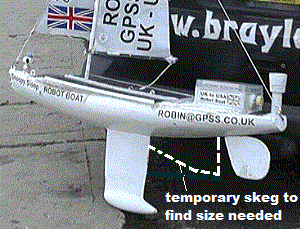 The goal is to launch Snoopy on this same Boat 10, early in 2015, as soon as we get another "weather window".
Before that we must complete minor repairs, including scratched paintwork and labels, and make what
modifications we can in the time available, allowing plenty of time for final Bray Lake Tests,
and at least a week of 24/7 test. We want Snoopy to have a better chance of success than last time.
The task requiring most time relates to confirming that the boat suffers from weather helm, and fixing it.
The goal is to launch Snoopy on this same Boat 10, early in 2015, as soon as we get another "weather window".
Before that we must complete minor repairs, including scratched paintwork and labels, and make what
modifications we can in the time available, allowing plenty of time for final Bray Lake Tests,
and at least a week of 24/7 test. We want Snoopy to have a better chance of success than last time.
The task requiring most time relates to confirming that the boat suffers from weather helm, and fixing it.
We plan to make a temporary detachable "skeg" or rearward keel extention. On suitable days at Bray Lake, first the boat will be tested as it is now. The skeg will then be fitted, and the tests repeated. The main data collected will be the GPS Plots, which show up weather helm nicely - if there is a good wind to produce it. The material used for the temporary skeg will be something like soft plastic, so it can be cut easily at Bray Lake, reducing it in size, until sailing balance of the boat seems correct.
A more robust skeg will then be made, and tests continued, including with other modifications, such as software changes. We already have the next version of the software that includes a new intermediate waypoint, over 13 miles south of Weymouth - so Snoopy "keeps his distance" from Portland ! :-)
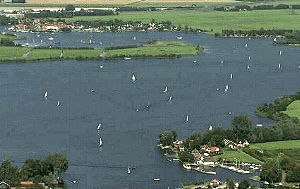 I am no sailor, but I did potter about in the 1970s, with work-mates who were experienced enough to take me
out, in the sailing boats owned by our employer. That's when I realised sailors liked to use
the right jargon, like "sheets" instead of ropes. Also all those other terms, like
"going about", "prepare to jibe", and "man overboard".
We did our sailing on
a large lake called the Braassememeer, north of Leiden, in Holland. I do remember, on one lovely day,
seeing a sailing boat, slip it's moorings, with it's sails up, in very light wind,
and sail itself unaided, crewless, across the lake, in what seemed a perfectly straight line.
The lake was about a mile across, and the boat was soon lost from sight, among other boats.
I think the two sailors were occupied, helping two girls, whose smaller boat
was sinking under them, near the pier they had moored, to eat their sandwiches.
I understand that it all ended happy ever after.
I am no sailor, but I did potter about in the 1970s, with work-mates who were experienced enough to take me
out, in the sailing boats owned by our employer. That's when I realised sailors liked to use
the right jargon, like "sheets" instead of ropes. Also all those other terms, like
"going about", "prepare to jibe", and "man overboard".
We did our sailing on
a large lake called the Braassememeer, north of Leiden, in Holland. I do remember, on one lovely day,
seeing a sailing boat, slip it's moorings, with it's sails up, in very light wind,
and sail itself unaided, crewless, across the lake, in what seemed a perfectly straight line.
The lake was about a mile across, and the boat was soon lost from sight, among other boats.
I think the two sailors were occupied, helping two girls, whose smaller boat
was sinking under them, near the pier they had moored, to eat their sandwiches.
I understand that it all ended happy ever after.
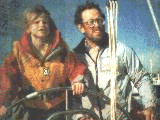 I did take a trip across the Solent, with my young family, many years ago,
and you can see relevant pictures and video on my old, 1998,
On Water page.
This trip was many years before 1998, in the 1980s.
I did take a trip across the Solent, with my young family, many years ago,
and you can see relevant pictures and video on my old, 1998,
On Water page.
This trip was many years before 1998, in the 1980s.
My most useful information has been gained from talking to experienced model sailing boat fanatics, at our local sailing clubs near here. It was Roger Stollery who first suggested that I try a conventional design - and that's what I soon adopted. Why try and re-invent something that has evolved over hundreds, or even thousands of years ? No Problem - if you appreciate the size of job you are taking on :-)
Of course, the most useful experience is when things go wrong, during the countless days of sailing Snoopy's boats on Bray Lake. Chatting during a coffee or lunch in the Bray Lake Watersports Clubhouse can also be useful - some there have a lot of experience teaching sailing both on inland water and the sea.
That sort of experience is also safer and more enjoyable :-)
More pictures from the 1980s, from our old family photo albums, now also on that "on water" page above. That's daughter Samantha at the helm this time :-)

© 1991-2014 Robin Lovelock. Please credit www.gpss.co.uk if you use material from any of these pages. Thankyou.